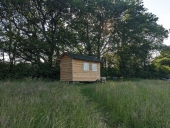








Seed the Mind, Harvest Ideas.
http://farmwhisperer.com




I don't have very much big pine, but I have lots of nice, thick oaks all over the property. I'm wondering if I used oak instead of pine (which is heavier, stronger, bendier, slower to dry, harder to nail) could I make the hosue with the studs farther apart?
I have been reading Ken Kern, and he says that if people used big shank nails instead of crummy 16-penny nails they could build with their studs 7 ft on center instead of 2! WOw! But then, he died when a building collapsed on him, so I wonder how seriously I should take him...












"If you want to save the environment, build a city worth living in." - Wendell Berry








Brian has a point, but this is also your house. It is your home, your dream and your aspirations. Neighbor is one thing and a friend another, if they really care, they want to help you fulfill you dreams. If I can teach and talk folks through timber frame projects over the web, as I do every day, you can have a timber frame if that is what you want.I have to be honest, by accepting so much help from my neighbor I'm beholden to him. This guy is my best friend out here (I am a city person by birth) and he looks out for me.
I can not begin to say how wrong and untrue that statement is! Most homes in the world, (all the oldest ones currently lived in,) are earth, stone and timber. You just don't see most homes that are stick build lasting more than 25 to 50 years, and that is coming from statisics direct from some of the major producers in the industry. Today's stick built/modular architecture is designed to and I quote an industry expert, Though the homes are designed and engineered and look good, they have an economic life of only about 25 years. Timber frames do require an unrealistic amount of skill...if you are by yourself, have now one to guide you and perhaps have limited mental faculties. However, if we can have small children cutting simple joints and teenagers designing and cutting there own frames thorough some of our programs, you can cut your own frame with just the simplest of hand tools, moral support, and some guidance. I wouldn't have you build a replica of a Japanese Minka or a Turkish Mountain house, but you could have a simple little frame that incorporates those elements.So he feels that a cobb house is unproven and probably unfit to live in. He thinks a timber-frame requires an unrealistic amount of skill.
I think you will regret that. You need to build your own house and follow your own counsel after you have considered all the opptions and considerations. Southern Missouri and the Ozarks are where all my mothers people came from. You have a wonderful place to build a home, and beautiful resources to create a timber frame with, more than most. If you don't believe me about some of the things I am saying, contact my friend Ziggy at "Dancing Rabbit," he will tell you the same thing. http://www.small-scale.net/yearofmud/#.UQYtOR1EGSoSo he wants to do a stud frame, and I'm willing to oblige him.




















"If you want to save the environment, build a city worth living in." - Wendell Berry














